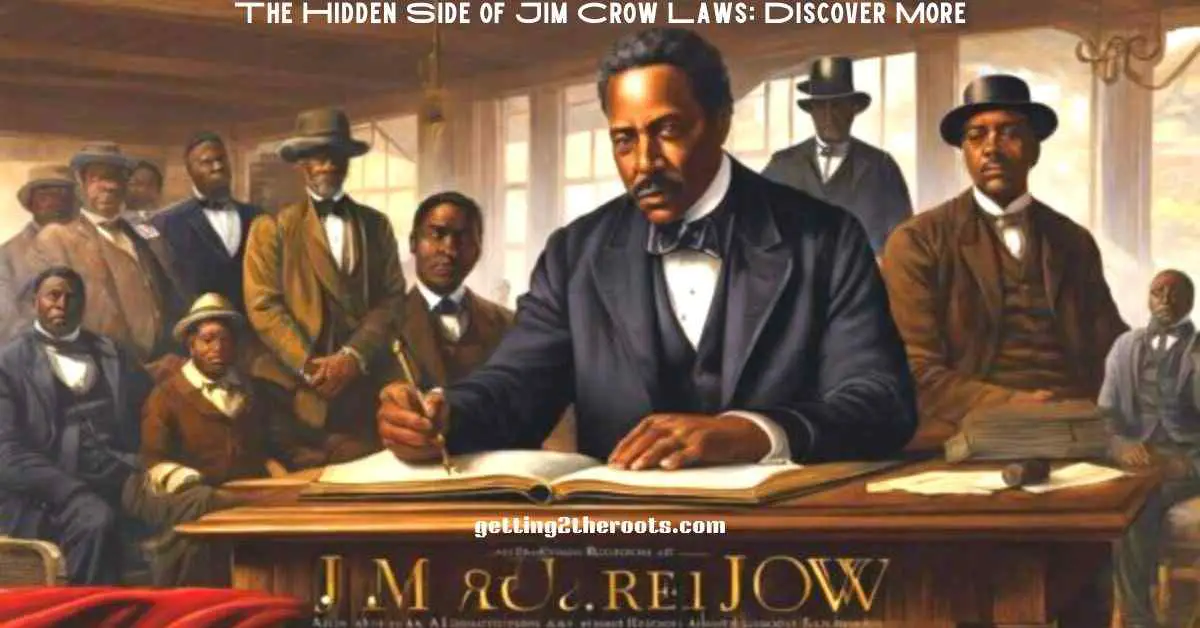The Jim Crow Laws, deeply rooted in the Southern United States after the Civil War, epitomize the severe truth of officially sanctioned racial division.
In this comprehensive overview, we explore the origins, establishment, and effects of these laws. Delve into the stories of prominent figures who resisted this oppression under Jim Crow Laws.
Understand their transformative journey. This journey led to the eventual demise of these laws. Discover how Jim Crow Laws systematically marginalized African Americans.
These laws affected the social, economic, and political spheres. Their lasting impact continues into the post-Jim Crow era.
Discover the untold stories of the Atlantic Slave Trade in our eye-opening article. “Dark Secrets of the Atlantic Slave Trade Finally Exposed.” Click Here to explore this crucial part of history.
What are the Origins and Establishment of Jim Crow Laws?
Genesis and Foundational Elements of Jim Crow Laws:
The Jim Crow Laws, a set of oppressive rules. Which played a pivotal role in the historical study of racial segregation in the United States.
Their structural architecture and enduring presence deeply mired an entire race in systemic oppression.
These laws form a critical aspect of understanding the complexities and long-standing impacts of racial segregation in American history.
Exploring the roots of Jim Crow Laws uncovers their key elements, shedding light on past racial dynamics. Understanding the lasting societal impact of Jim Crow laws becomes clearer when we consider their origins.
The term ‘Jim Crow’ itself derives from a 19th-century song, “Jump Jim Crow,” performed in blackface by Thomas Dartmouth “Daddy” Rice, which ridiculed African Americans.
This song’s popularity grew to symbolize state-enforced racial segregation in the U.S. from the late 19th to mid-20th centuries. This segregation under Jim Crow Laws impacted every part of American society during that era.
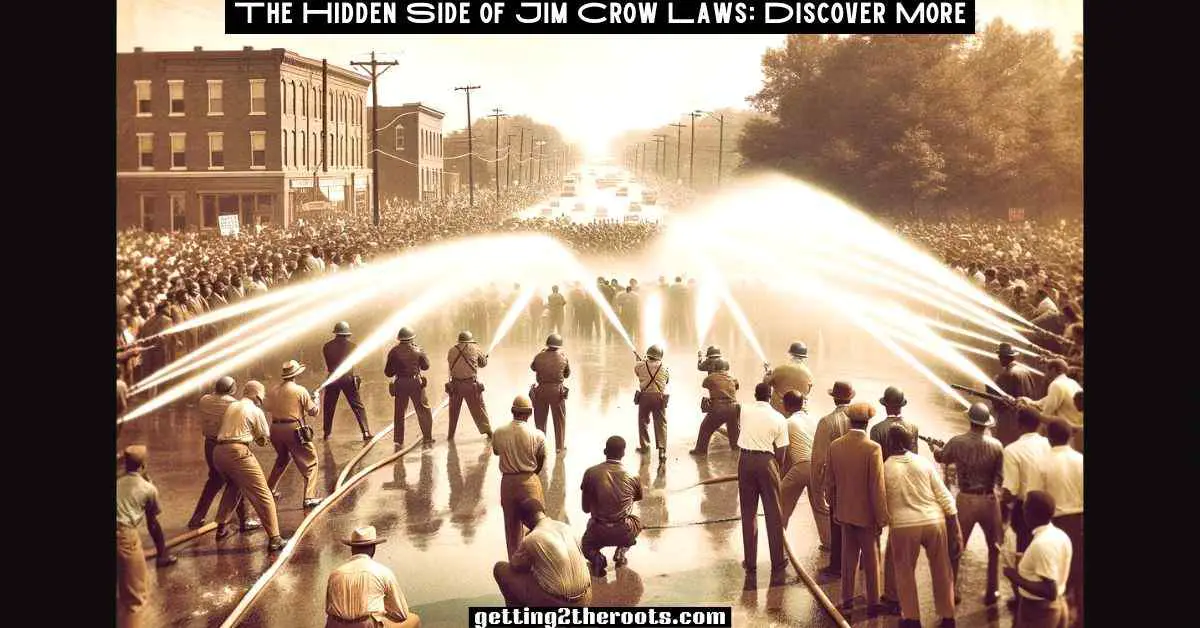
The Historical Context of Jim Crow Laws in the Post-Reconstruction Era
This socio-legal construct, known as Jim Crow Laws, emerged in the post-Reconstruction South.
This period followed the abolition of slavery. And saw growing desperation among whites to maintain the socio-economic hierarchy slavery had fostered.
These laws were a response to this desperation, reinforcing racial segregation and inequality. The origins of Jim Crow Laws trace back to the Black Codes during the Reconstruction Era (1865–1877).
These codes aimed to control and restrict the African-American populace. They set the stage for the development of Jim Crow Laws in this turbulent period.
The Black Codes and subsequent Jim Crow Laws were twin socio-political forces. They aimed to bypass the Fourteenth and Fifteenth Amendments.
These amendments granted rights to recently freed African Americans. Jim Crow Laws thus represented a deliberate effort to undermine these new liberties.
At the core of the Jim Crow legislation, the concept of ‘separate but equal’ was a central tenet. This notion of ‘separate but equal’ received legal validation from the 1896 Supreme Court ruling in the case of Plessy vs. Ferguson.
The decision in Plessy vs. Ferguson essentially provided a constitutional facade to the already existing practices of segregation. This endorsement led to the reinforced and widespread implementation of Jim Crow Laws, deepening segregation in numerous aspects of society.
It sanctioned the separation of races in public facilities, transportation, and education. As long as these separate facilities were purportedly equal, a standard that was rarely, if ever, met in practice.
This ruling became a pivotal moment in American history, legitimizing and perpetuating systemic racial discrimination for decades.

The Enforcement and Violence Underpinning Jim Crow Laws
The Jim Crow laws encompassed a wide array of public spheres. They enforced mandatory segregation in transportation, education, public facilities, and housing.
These laws also banned interracial marriages through anti-miscegenation laws. They severely limited the voting rights of African Americans. Methods like literacy tests, poll taxes, and grandfather clauses were used.
The Enforcement and Violence Underpinning Jim Crow Laws
Moreover, the enforcement of Jim Crow Laws was often unilateral and violent. This violated the constitutionally guaranteed equal protection under the law.
The laws were enforced in a way that disregarded constitutional rights. These flagrant transgressions under Jim Crow Laws were state-sanctioned and even socially praised.
Widespread racial violence was a hallmark of the Jim Crow era. The horrifying spectacles of public lynchings typified this time period.
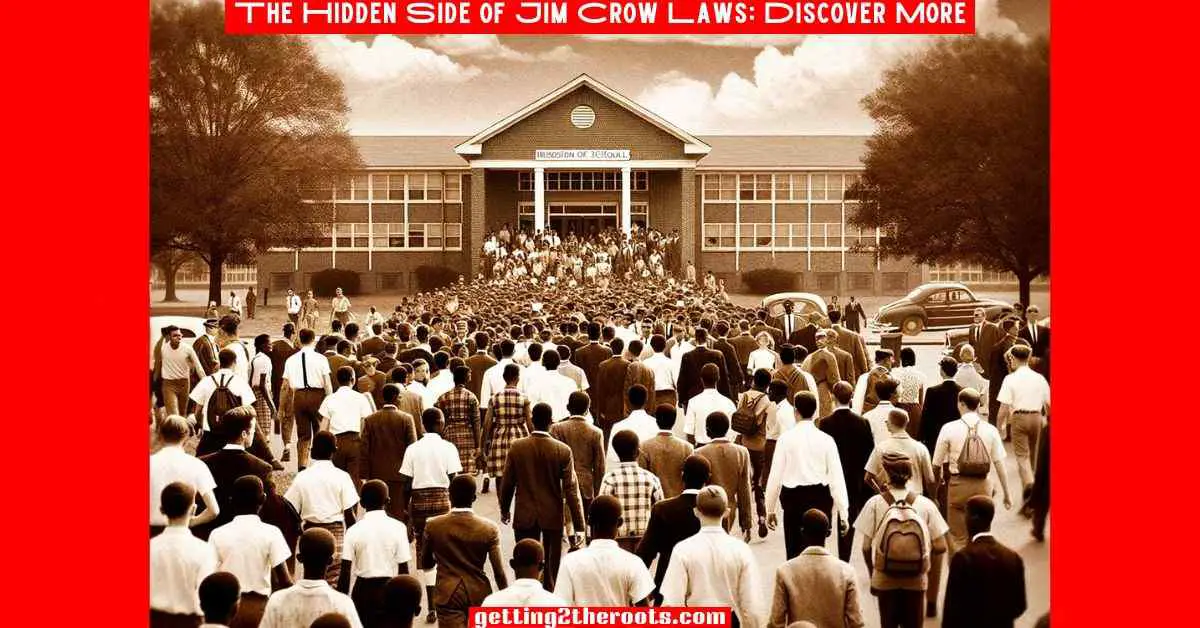
The Deep-Rooted Legacy of Jim Crow Laws in American Society
Jim Crow laws in the U.S. officially ended with the Civil Rights Act (1964) and the Voting Rights Act (1965).
Even though legal segregation under Jim Crow Laws has ended, its socio-cultural impacts persist, manifesting in ongoing systemic racial disparities.
The deep embedding of these historical laws in society’s fabric is evident in the de facto segregation that is occurring today as a result of prevailing prejudices and economic inequalities.
Due to this, it’s imperative to study the genesis and foundational elements of Jim Crow Laws. This study helps chart a course toward racial equality. Understanding these laws is key to addressing current racial issues.
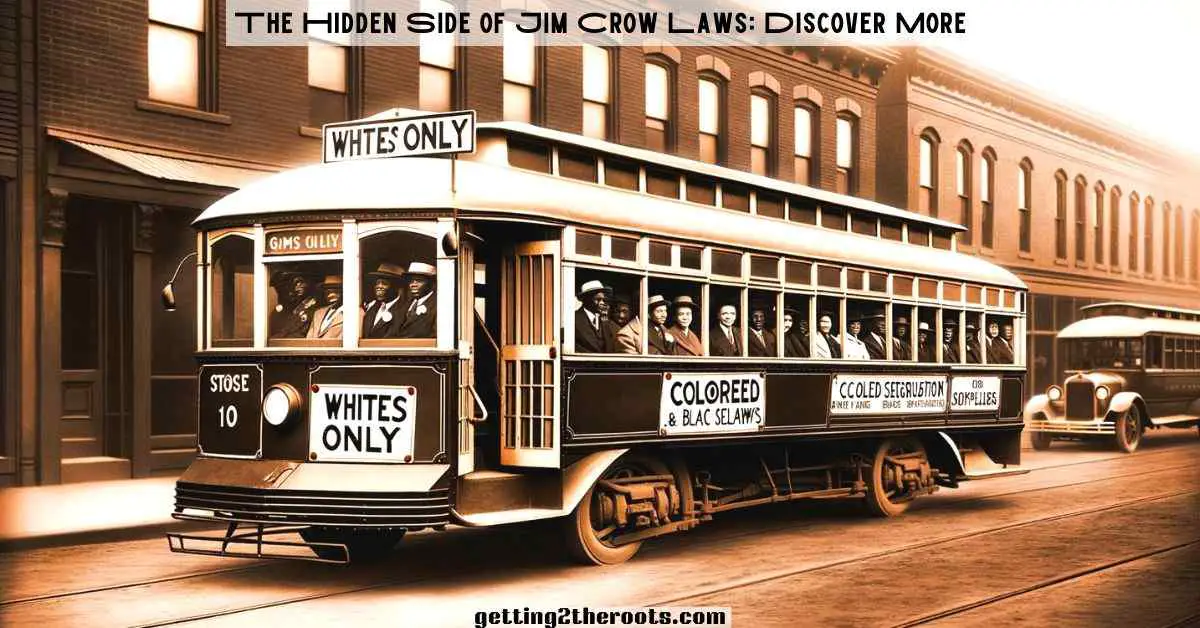
Implications and Effects of Jim Crow Laws
Societal Implications of Jim Crow Laws
The societal ramifications of Jim Crow Laws were vast and varied. They were grounded in a desire to cement white superiority. This goal influenced various aspects of society.
These laws entrenched the norms of racial segregation and discrimination, perpetuating the notion of racial inadequacy among African Americans.
Public spaces became contested terrains where the drawn lines of separation pervasively framed social interactions.
The normative backdrop of Jim Crow Laws was a climate of fear. African Americans faced a constant risk of violence for perceived social norm violations.
This created a psychological advantage for whites, rooted in domination. This racial violence, under Jim Crow Laws, corroded the self-esteem of African Americans.
It reinforced a hierarchy of racial subordination. This led African Americans into a vortex of socio-psychic insecurity.
Educational Implications of Jim Crow Laws
The doctrines of Jim Crow had a profound impact on education, enforcing rigid segregation allowed by the “separate but equal” principle established in Plessy vs. Ferguson.
This decree, however, was often a misnomer, as adequate resources and funds were rarely apportioned equally. School facilities for African American children were markedly inferior, teachers were less qualified, and student-to-teacher ratios were almost invariably unfavorable.
Generations of African Americans were deprived of equal educational opportunities. They lacked access to intellectual resources. This led to a limited scope of learning that was intentionally truncated. As a result, their future opportunities and socio-economic mobility were significantly diminished.
Economic Implications of Jim Crow Laws
At an economic level, Jim Crow laws served to impoverish African Americans continuously. The rules imposed strict limitations on black labor, marshaling them into positions of servitude both in their freedom and earning capacity.
Racial discrimination in the realms of employment and promotion remained commonplace, curtailing the potential for economic advancement.
Political Implications of Jim Crow Laws
Politically, a superordinate goal of Jim Crow laws was to suppress black voter turnout. Literacy tests, poll taxes, and grandfather clauses created insurmountable barriers.
Many African Americans faced these obstacles when exercising their democratic rights. These measures significantly hindered their ability to vote.
Consequently, the voice of an entire demographic was largely silenced, undercutting the principle of universal suffrage. White political supremacy was perpetuated through these measures. This led to long-lasting disparities in representation and policy-making. These disparities continued even after the official end of Jim Crow Laws.
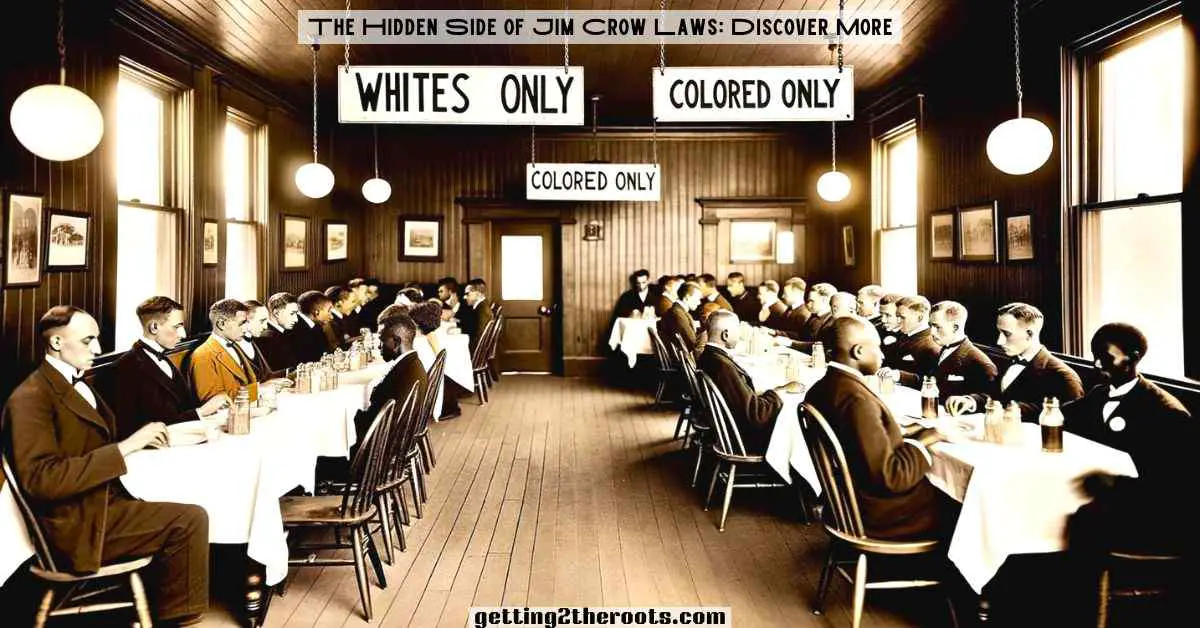
Prominent Figures and Acts of Resistance
Prominent Figures Who Resisted Jim Crow Laws and Their Strategies
Even under the oppressive regime of Jim Crow laws, a vanguard of individuals emerged. They stood firm against racial injustice. These individuals challenged the oppressive system. The resilience of pivotal figures in the fight against racism is noteworthy.
Their courage and strategic resistance against structural racism form a rich narrative. This defiance deserves scholarly acknowledgment.

A critical figure in this narrative of resistance was the “mother of civil rights,” Rosa Parks. Despite strict bus segregation laws, Rosa Parks refused to surrender her seat to a white man.
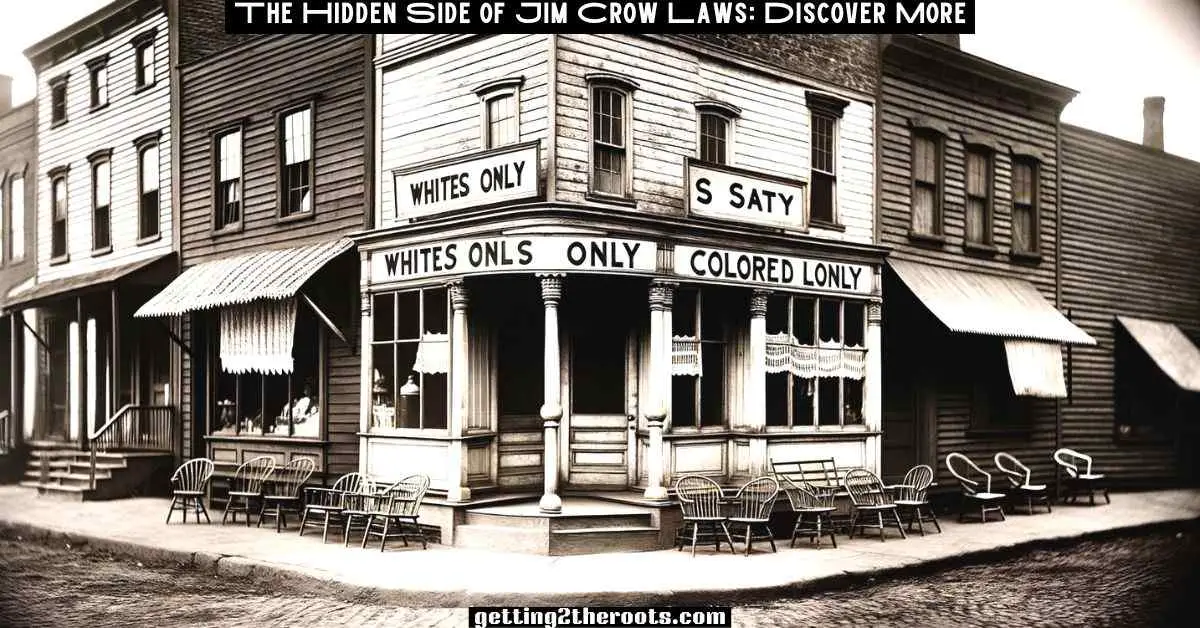
Her principled stance symbolized an act of civil disobedience. This act later catalyzed the Montgomery Bus Boycott. This strategic, nonviolent action was inspired by Mahatma Gandhi’s teachings. It highlighted the economic leverage of African Americans.
This led to a significant decline in Montgomery’s public transportation revenue. Ultimately, it resulted in the abolition of bus segregation in the region.
Underpinning this resistance was the consequential role of the National Association for the Advancement of Colored People (NAACP). Founded in 1909 by W.E.B. Du Bois and others, the NAACP fought legal battles against Jim Crow regulations.

They championed cases like Brown vs. Board of Education. This ultimately led to the dismantling of segregation in public schools.
One cannot discuss figures of resistance without mentioning Dr. Martin Luther King Jr. His profound oratory skills, coupled with a philosophy of nonviolent resistance, resonated widely.
This impact was felt both within and outside the African American community. It effectively rallied support against Jim Crow Laws.
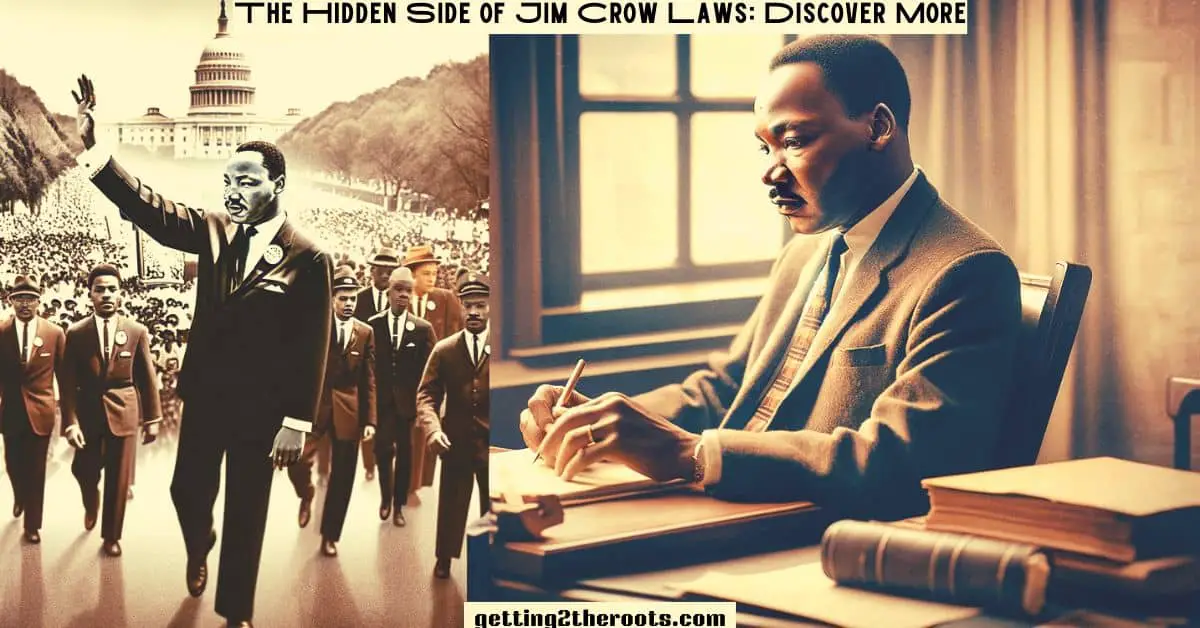
His famous “I Have a Dream” speech was delivered during the 1963 March on Washington.
It remains iconic, echoing as a narrative of racial equality aspirations. This speech continues to inspire today.
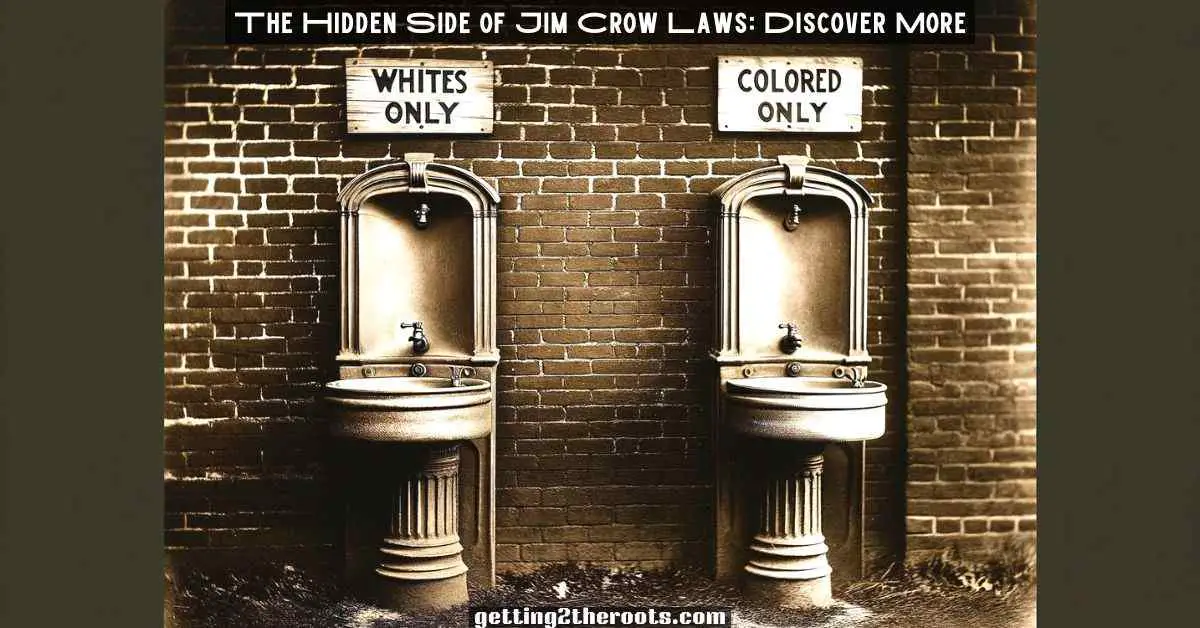
In tandem with this public defiance by individuals and organizations, resistance was also brewing within popular culture.
Artists such as Paul Robeson used their platforms to challenge racist societal norms.
His artistry, through music and film, provided a potent critique of the racial status quo.
It instilled a sense of pride in African Americans and appreciation for their cultural heritage.
Simultaneously, it fostered empathy among segments of the white population. Then there was the formation of the Student Nonviolent Coordinating Committee (SNCC) in 1960.
The SNCC, mostly young African American students, adopted direct-action strategies. They engaged in sit-ins and freedom rides. This was despite the risk of violent reprisals.

Their efforts brought civil rights issues to national and international attention. This significantly advanced the movement. It led to the further abolition of legally sanctioned racial discrimination.
The NAACP Legal Defense and Educational Fund played another key role. Its lead counsel, Thurgood Marshall, was later appointed the first African American Supreme Court Justice.
He devoted his career to dismantling the legal foundations of Jim Crow laws. His work significantly impacted civil rights legislation.
He strategically chose court cases that challenged the ‘separate but equal’ doctrine.
This approach successfully laid the groundwork. It ultimately led to the abolishment of these discriminatory laws.
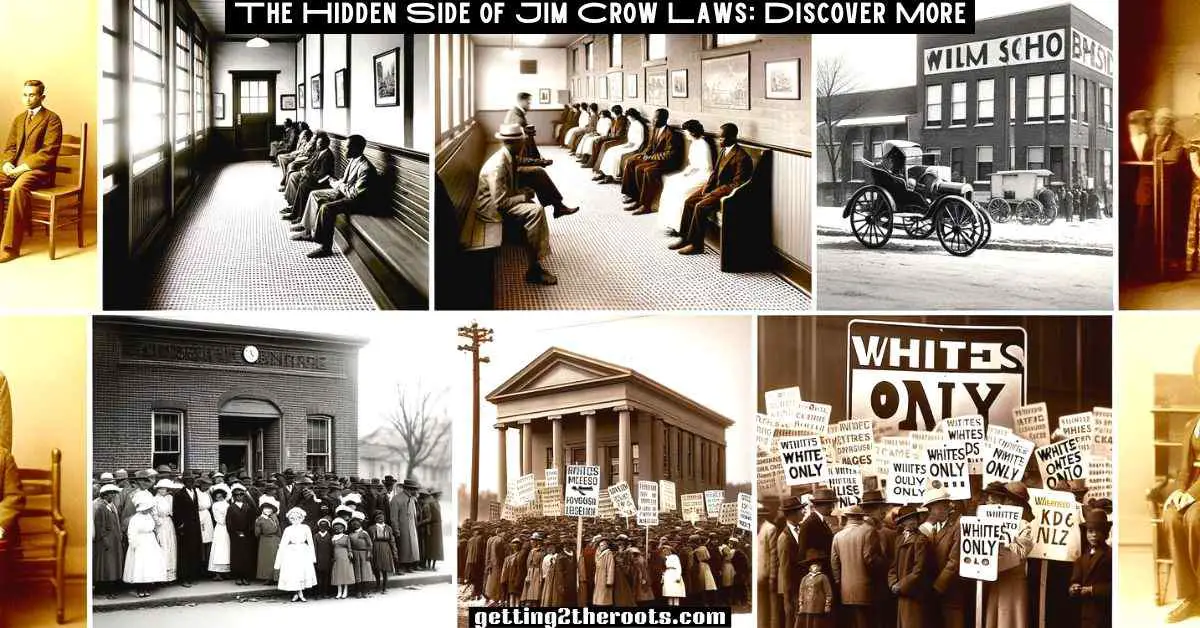
Finally, there were myriad unsung heroes in the resistance against Jim Crow. Ordinary men and women who challenged the stipulations of Jim Crow in their daily routines, in public transportation, schools, and churches.
Their collective resistance provided the socio-cultural backdrop that sustained the protracted struggle for equality.
The Demise of Jim Crow Laws and Post-Jim Crow Era

The conclusion of the Jim Crow Laws era is rooted in the tireless efforts of civil rights activists and organizations.
The battle against injustice had well-known names like the NAACP and Dr. Martin Luther King Jr.
It also included often overlooked ‘ordinary individuals.’ Each of them possessed extraordinary fervor for justice and equality.

The Montgomery Bus Boycott was initiated by Rosa Parks’ defiant act. It roused the nation’s conscience against transportation segregation.
This was one of many areas controlled by Jim Crow laws. It marked a pivotal point in history. This event demonstrated the power of non-violent resistance.
It showed how it can effectively bring about change. Simultaneously, the legal battles against Jim Crow laws were initiated by organizations like the NAACP.

Led by figures like Thurgood Marshall, the NAACP Legal Defense and Educational Fund propelled the civil rights movement forward in the courtroom.
Their efforts led to monumental Supreme Court decisions. One such decision was Brown vs. Board of Education. This case nullified the ‘separate but equal’ principle. It laid the groundwork for dismantling Jim Crow laws.
Artists, too, played a significant role in challenging the societal norms undergirding racial segregation. Paul Robeson is exemplary, using his art to assert the commonalities of the human condition and dispel the fabricated racial divide.
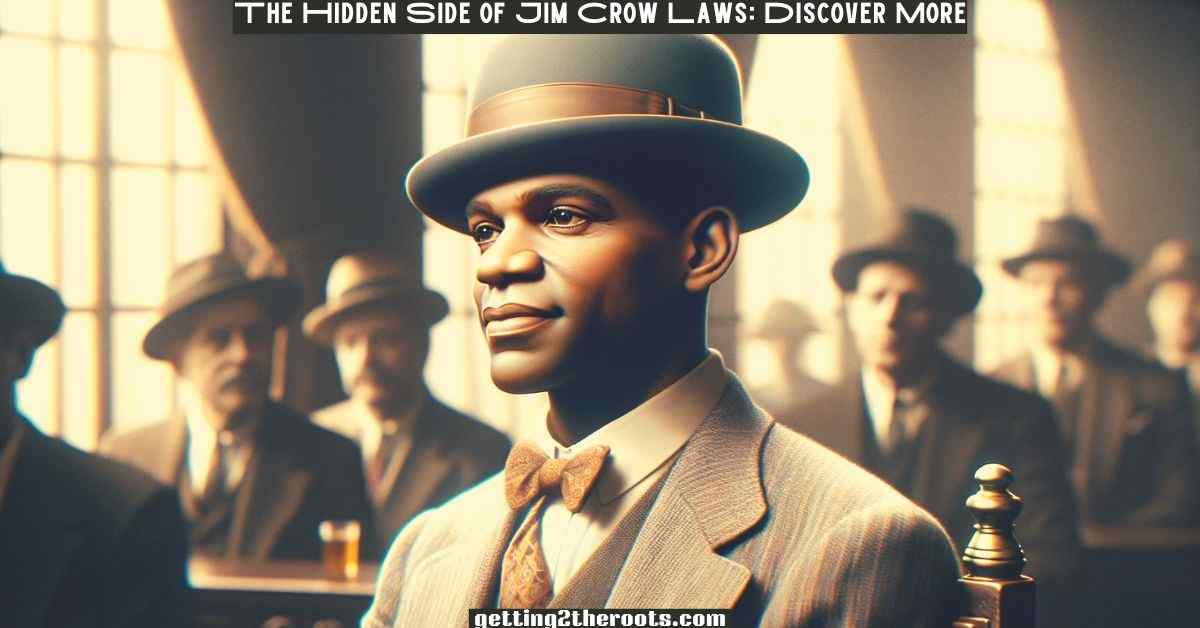
Parallel to these developments, the Student Nonviolent Coordinating Committee (SNCC) was formed. It underscored Dr. King’s ethos of nonviolent resistance. The SNCC emphasized youth mobilization against Jim Crow restrictions.
This concerted effort bore fruit with the passage of the Civil Rights Act of 1964 and the Voting Rights Act of 1965. Which officially invalidated the remaining Jim Crow laws, thereby ending the epoch of legalized racial segregation.
The societal aftermath, however, remains palpable. Echoes of Jim Crow-era discriminatory practices remain entrenched in our social structure. Disparities in education reflect residues of the “separate but unequal” approach. Racial minorities are disproportionately affected by this.
They face a lack of resources and opportunities. Economic limitations persist, as seen in the prevailing wealth gaps. The black community faces barriers to economic advancement. These barriers continue to affect their financial progress.
Moreover, various forms of voter suppression efforts aim to limit black voter turnout. These efforts draw parallels with voting rights restrictions under Jim Crow. Such suppression tactics are a modern reflection of past injustices.
Although not enshrined in law, these practices endure in structure. They effectively exclude this population from political processes. This exclusion continues to impact the political engagement of African Americans.
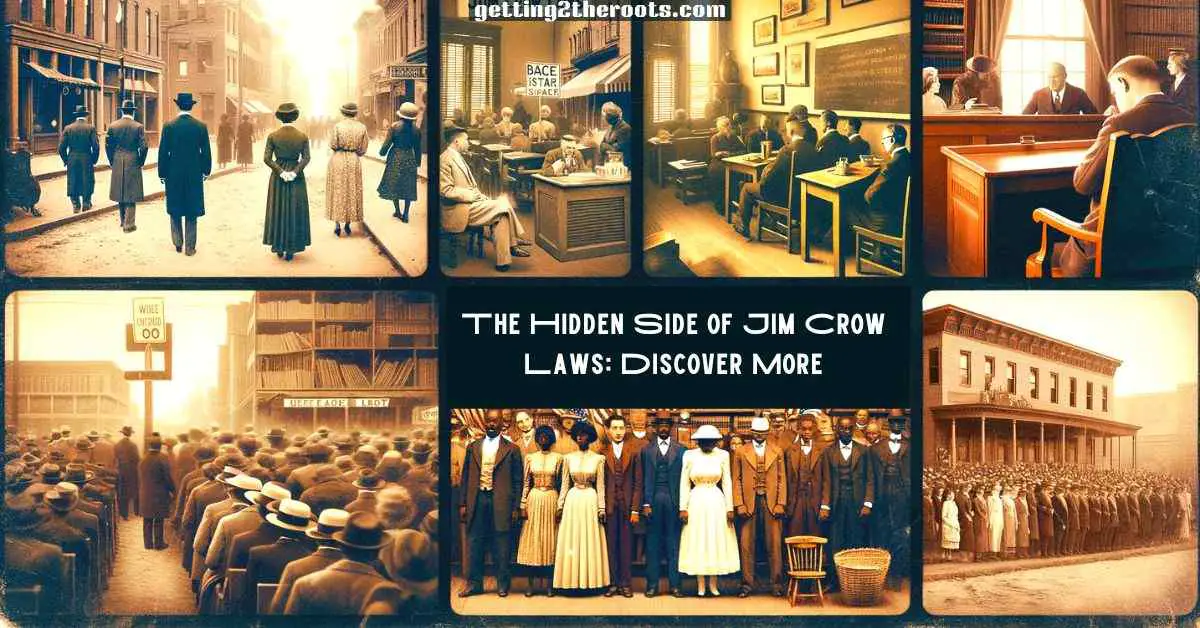
Conclusion
In conclusion, the Jim Crow Laws era concluded with significant legal strides toward equality. However, the undercurrents of its discriminatory ideologies can still be identified within societal frameworks, reminding us of the ongoing struggle for racial equality.
It reinforces the importance of diligent vigilance in identifying and addressing disguised manifestations of these laws, reflecting an unfaltering pursuit of justice.
Society’s evolution is dynamic, with the transition from explicit to implicit manifestations of discrimination pointing at the complexities added to this ongoing fight for equality.
Despite these challenges, the conclusion of the Jim Crow Laws era presents a beacon of progress, underscoring the wins human society can achieve, albeit late, in its pursuit of justice and equality.
The twilight of Jim Crow Laws through landmark legal cases and the subsequent desegregation of public facilities marked a significant turn in American history.
However, the echoes of segregationist doctrines continue to reverberate and influence contemporary race relations in America.
The emergence of a new societal structure in the post-Jim Crow era continues to struggle as it wrangles with its deeply prejudiced past and seeks to establish a truly equitable future.
The legacy of Jim Crow, therefore, persists as a reminder of a chapter best not repeated and an inspiration for the relentless pursuit of justice and equal rights.

FAQ: Understanding Jim Crow Laws
- What were the Jim Crow Laws? Answer: The Jim Crow Laws were a series of state and local statutes in the United States, primarily in the South, that enforced racial segregation from the late 19th century through the mid-20th century. These laws created a “separate but equal” status for African Americans, which in practice was rarely equal and deeply discriminatory.
- How did Jim Crow Laws originate? Answer: The term “Jim Crow” originated from a racist song and dance routine from the early 19th century. These laws began to take shape after the Reconstruction era, as Southern states sought to reestablish white supremacy and control over African Americans.
- What areas of life did Jim Crow Laws affect? Answer: Jim Crow Laws affected almost all aspects of daily life, including segregation in public facilities like schools, transportation, restrooms, and restaurants. They also imposed restrictions on voting rights and interracial relationships.
- Were Jim Crow Laws the same across all states? Answer: While Jim Crow Laws were widespread, especially in the Southern states, their specific provisions varied from state to state. However, the overarching theme was the same: to maintain racial segregation and suppress the rights of African Americans.
- How and when did Jim Crow Laws end? Answer: The Civil Rights Movement, particularly during the 1950s and 1960s, played a crucial role in ending Jim Crow Laws. Key events, like the Supreme Court’s decision in Brown vs. Board of Education in 1954, which declared state laws establishing separate public schools for black and white students unconstitutional, and the Civil Rights Act of 1964, which prohibited discrimination based on race, color, religion, sex, or national origin, were instrumental in dismantling these laws. The movement culminated in the Voting Rights Act of 1965, which overcame legal barriers at the state and local levels that prevented African Americans from exercising their right to vote.

